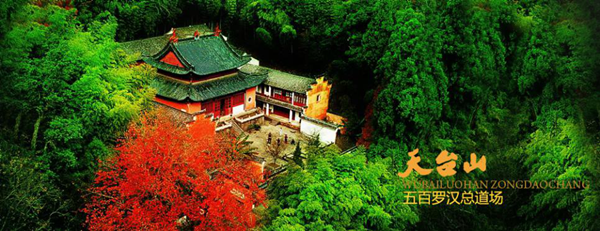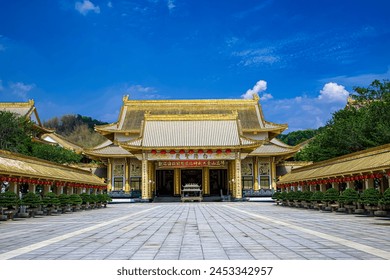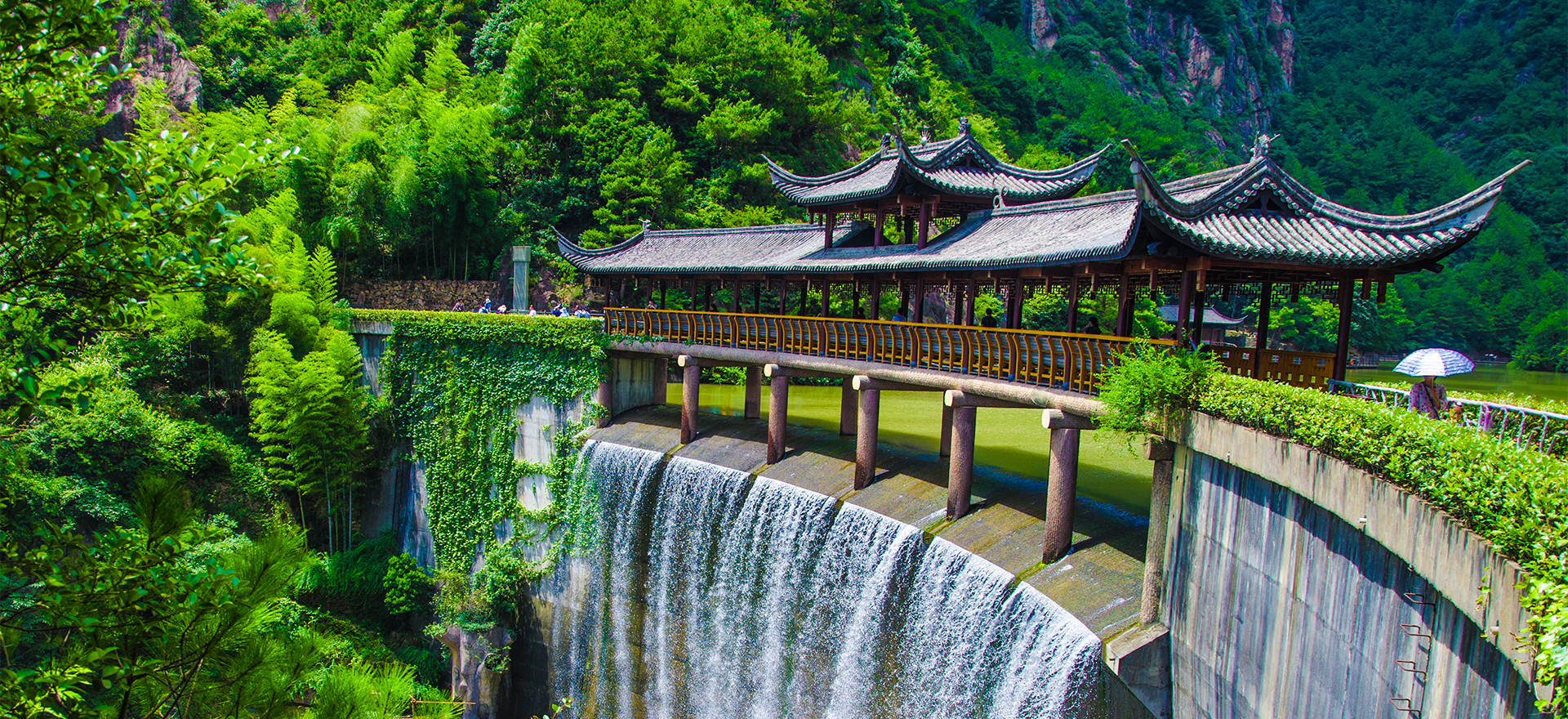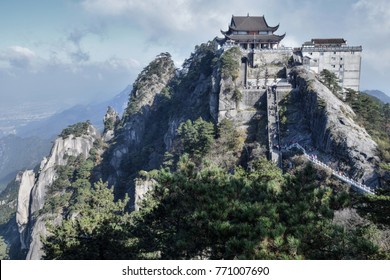A Traveler’s Guide to Tiantai Mountain Buddhist Temple: Embrace the Calm Within

An Essential Guide to Visiting Tiantai Mountain Buddhist Temple
Nestled in the serene landscape of Zhejiang Province, the Tiantai Mountain Buddhist Temple offers an enchanting blend of spiritual heritage and breathtaking natural beauty. This revered site, known as the birthplace of Tiantai Buddhism, beckons travelers from around the globe to explore its rich history and profound cultural significance. With its majestic peaks, ancient temples, and tranquil surroundings, Tiantai Mountain serves as a sanctuary for those seeking solace, enlightenment, or simply a peaceful retreat from the hustle and bustle of modern life.
As you wander through the temple grounds, you’ll encounter stunning architectural marvels that have stood the test of time, including the iconic Guoqing Temple, a magnificent structure that dates back to the Sui Dynasty. The air is imbued with a sense of spirituality, where the chants of monks and the soft rustle of leaves create a harmonious symphony that resonates with the soul. Each corner of this sacred space tells a story, inviting you to delve deeper into the philosophies of Buddhism, Taoism, and Confucianism that have flourished here for over 1,800 years.
The surrounding landscape, characterized by lush forests, towering cliffs, and cascading waterfalls, enhances the spiritual experience, allowing visitors to connect with nature in a remarkably profound way. Whether you’re an avid hiker or a contemplative seeker, Tiantai Mountain invites you to explore its trails, each offering mesmerizing views and a chance to reflect on the teachings that have inspired countless souls throughout history.
In this guide, we will unveil the essential aspects of visiting the Tiantai Mountain Buddhist Temple, providing you with insights into its main attractions, cultural significance, local delicacies, and practical tips to ensure a memorable pilgrimage. Prepare to embark on a journey of discovery and tranquility in one of China’s most revered spiritual destinations.
In This Guide
- An Essential Guide to Visiting Tiantai Mountain Buddhist Temple
- The Rich History and Legends of Tiantai Mountain Buddhist Temple
- Main Highlights: What You Absolutely Can’t Miss
- Planning Your Visit: A Practical Guide
- Tickets: Prices, Booking, and Tips
- How to Get There: A Complete Transportation Guide
- Local Cuisine and Accommodation Nearby
- Frequently Asked Questions
- Final Thoughts on Your Trip
The Rich History and Legends of Tiantai Mountain Buddhist Temple
Nestled in the stunning natural landscape of Tiantai Mountain in Zhejiang Province, the Tiantai Mountain Buddhist Temple, also known as Guoqing Temple, stands as a testament to the rich tapestry of Chinese Buddhism and culture. With a history spanning over 1,800 years, this sacred site is not only a center for spiritual enlightenment but also a cornerstone of regional folklore and philosophical development.
The temple’s origins date back to 598 AD during the Sui Dynasty, initially named Tiantai Temple. The name was later changed to Guoqing Temple, symbolizing the hope that the country would achieve peace through the completion of this revered place of worship. Over the centuries, it has been a vibrant hub for the practice and dissemination of Tiantai Buddhism, one of the significant schools of Chinese Buddhism, which emphasizes enlightenment through meditation and insight into the nature of reality.
Tiantai Mountain itself has long been celebrated as the birthplace of this unique Buddhist philosophy, particularly during the Tang and Song Dynasties when it flourished. Central to Tiantai Buddhism are fundamental concepts such as “One Thought, Three Thousand Realms,” which teaches that an individual’s mind can encompass the entire universe. This profound philosophical framework has influenced countless practitioners and thinkers throughout Chinese history.
The temple complex is an architectural marvel, sprawling over 73,000 square meters and comprising more than 800 rooms. Its grandeur is complemented by a series of halls and relics that narrate the temple’s historical significance. Among its treasures is the ancient “Sui Mei,” a plum tree planted by Master Zhang’an over 1,400 years ago, and invaluable scriptures left behind by revered monks. Indeed, Guoqing Temple is not only a sanctuary for worshippers but also a repository of Buddhist heritage that has influenced spiritual practices in neighboring countries, including Japan and Korea.
Legends and stories abound in the vicinity of the temple, infusing the air with a sense of mystique. Local folklore speaks of the encounters between Liu and Ruan with immortals, weaving a narrative that echoes the intertwining of the divine and the earthly. Such tales reflect the cultural richness of the region, where history and spirituality converge.
As visitors explore the temple grounds, they will encounter the profound serenity that has attracted countless scholars, poets, and monks throughout the ages. The legacy of Tiantai Mountain Buddhist Temple is not merely confined to its historical significance; it embodies a living tradition that continues to inspire spiritual seekers and curious travelers alike.
In summary, the Tiantai Mountain Buddhist Temple is a monument to the enduring legacy of Chinese Buddhism. It stands as an invitation to delve deeper into the rich historical and spiritual narratives that have shaped the region, beckoning international travelers to partake in its timeless allure and profound wisdom. Whether seeking enlightenment, cultural understanding, or simply a moment of tranquility amidst nature, Tiantai Mountain and its revered temple offer an unforgettable journey into the heart of China’s spiritual heritage.

Tiantai Mountain Buddhist Temple.
Main Highlights: What You Absolutely Can’t Miss
When exploring Tiantai Mountain Buddhist Temple, there are numerous captivating attractions that immerse you in its rich cultural and natural landscape. Here’s a guide to the highlights you absolutely cannot miss:
Guoqing Temple (国清寺)
As the birthplace of Tiantai Buddhism, Guoqing Temple is a must-visit. Established in 598 AD, this expansive temple complex covers 73,000 square meters and boasts over 800 rooms. Marvel at the architectural grandeur and the serene ambiance that has attracted monks and pilgrims for centuries. Be sure to visit the ancient “Sui Mei,” a 1,400-year-old plum tree, and explore the myriad cultural relics, including the Pali scriptures and the famed “Single-Character Goose” stele by Wang Xizhi.
Shiliang Feipu (Shiliang Flying Waterfall)
This breathtaking natural marvel features a granite bridge that spans two cliffs, under which a waterfall cascades dramatically from a height of 40 meters. Known as one of the highlights of the “Tang Poetry Road,” the picturesque setting is perfect for photography and enjoying the harmonious blend of water and rock. The nearby Zhongfangguang Temple adds to the spiritual atmosphere, making this location a serene stop on your journey.
Tiantai Mountain Grand Waterfall (天台山大瀑布)
Claiming the title of the highest waterfall in China, Tiantai Mountain Grand Waterfall stands at an impressive 325 meters high. Its stunning height and width create a majestic spectacle, especially when viewed from the surrounding peaks. The waterfall is celebrated in local poetry and has been designated as a national 4A-level tourist attraction, making it a key feature of the Tiantai landscape.
Qiongtai Xiangu (Qiongtai Fairy Valley)
For those who enjoy hiking and nature, the enchanting Qiongtai Fairy Valley offers breathtaking scenery with its unique rock formations, tranquil streams, and lush greenery. The valley’s charm feels otherworldly, making it a perfect destination for leisurely walks or quiet reflection amidst nature.
Chicheng Mountain (赤城山)
Known as a dual-cultivation site for Buddhism and Taoism, Chicheng Mountain is a stunning area filled with red rock formations and ancient temples. The dramatic cliffs provide a striking backdrop for a spiritual journey, and the panoramic views from the top are simply breathtaking, allowing visitors to appreciate the beauty of the surrounding countryside.
Huading Forest Park (华顶森林公园)
As the main peak of the Tiantai Mountains, Huading offers a lush forest environment perfect for hiking and relaxation. The park is known for its stunning vistas, especially during the Yunjin Rhododendron Festival in May when the flowers bloom vibrantly. Standing atop the peak, you’ll feel a sense of tranquility as you gaze out over the breathtaking layers of mountains and clouds.
Culinary Delights
No visit to Tiantai is complete without sampling the local cuisine. Indulge in specialties such as Caoseed Rice Cake, a unique dish combining fresh caoseed with rice cake, or Jiaobingtong, a delicious stuffed pancake roll filled with various ingredients. Don’t miss the chance to try Dendrobium Medicinal Cuisine, which highlights the local dendrobium plant in various dishes, offering a taste of both the region’s culture and health benefits.
Conclusion
Tiantai Mountain Buddhist Temple is not just a spiritual haven but a gateway to experiencing the rich tapestry of Chinese history, culture, and nature. From ancient temples and stunning waterfalls to delightful local cuisine, the highlights of this sacred site promise an unforgettable journey for every traveler.

Tiantai Mountain Buddhist Temple.
Planning Your Visit: A Practical Guide
Planning Your Visit: A Practical Guide to Tiantai Mountain Buddhist Temple
Nestled in the breathtaking landscape of Zhejiang Province, Tiantai Mountain Buddhist Temple is not just a haven for spiritual seekers but also a visual feast for international travelers. Boasting a rich cultural heritage and stunning natural scenery, your visit to this historic site can be both enlightening and unforgettable. Here’s everything you need to know to make the most of your trip.
Getting There
By Air: The nearest major airport is Taizhou Luqiao Airport (HYN), which connects to several cities within China. From the airport, take a taxi or arrange for a shuttle to Tiantai Mountain.
By Train: The closest railway station is Taizhou Railway Station. High-speed trains from major cities like Shanghai and Hangzhou will get you to Taizhou in no time. From the station, you can catch a bus or taxi to Tiantai Mountain.
By Bus: Several long-distance buses operate from surrounding cities to Tiantai County. This is a budget-friendly option, but check the schedules in advance as they can vary.
Best Time to Visit
Tiantai Mountain experiences a subtropical monsoon climate, making it a year-round destination. However, the ideal time to visit is during spring (April to June) or autumn (September to November) when the weather is mild and the scenery is particularly beautiful. Be aware that summer can be hot and humid, while winter may bring cold temperatures and occasional snowfall.
Accommodation Options
On-Site Hotels: There are several hotels and guesthouses near the temple, ranging from budget-friendly to mid-range options. Staying close to the temple allows for easy access to early morning prayers and stunning sunrise views.
Local Homestays: For a more immersive experience, consider booking a homestay with a local family. This will give you insight into the region’s culture and cuisine.
Camping: If you’re an adventurous spirit, camping is permitted in certain areas of the scenic region, allowing you to experience the tranquil beauty of Tiantai Mountain up close.
Exploring the Temple
Main Attractions:
-
Guoqing Temple: This ancient temple, the birthplace of Tiantai Buddhism, is a must-visit. Marvel at its stunning architecture and historic relics, including the 1,400-year-old Sui Mei tree.
-
Shiliang Feipu (Shiliang Flying Waterfall): A natural marvel, this stunning waterfall cascades 40 meters down a granite bridge, creating a picturesque spot for photos.
-
Qiongtai Xiangu (Qiongtai Fairy Valley): Enjoy leisurely hikes through this beautiful valley, renowned for its striking rock formations and serene streams.
-
Tiantai Mountain Grand Waterfall: As the highest waterfall in China, this breathtaking sight is not to be missed—especially during the rainy season when it’s at its most powerful.
Food and Dining
After a day of exploration, treat yourself to local delicacies that highlight the flavors of Tiantai. Must-try dishes include:
- Caoseed Rice Cake: A flavorful rice cake served in a rich broth.
- Jiaobingtong (Stuffed Pancake Roll): A delightful pancake filled with an assortment of ingredients.
- Dendrobium Medicinal Cuisine: Sample dishes made with local herbs known for their health benefits.
For the full experience, look for restaurants that serve traditional cuisine and enjoy the warm hospitality of the locals.
Tips for Visitors
-
Dress Appropriately: Many areas, including temples, require modest clothing. Comfortable walking shoes are essential as the terrain can be uneven.
-
Respect Local Customs: As a significant spiritual site, maintain a respectful demeanor and follow any guidelines provided by temple staff.
-
Photography Etiquette: While photography is generally permitted, be mindful of where you take photos, especially during ceremonies.
-
Stay Hydrated: Bring a refillable water bottle, as you’ll be doing plenty of walking and exploring.
Conclusion
Tiantai Mountain Buddhist Temple offers a unique blend of spiritual significance and natural beauty. With careful planning, your visit can be a deeply rewarding experience filled with discovery, reflection, and connection to the rich cultural tapestry of China. Whether you seek spiritual enlightenment or simply a peaceful retreat, Tiantai Mountain welcomes all who wish to explore its wonders.

Tiantai Mountain Buddhist Temple.
Tickets: Prices, Booking, and Tips
When planning your visit to the Tiantai Mountain Buddhist Temple, it’s essential to be aware of ticket prices, booking options, and some handy tips to ensure a smooth experience.
Ticket Prices
Admission to the Tiantai Mountain Scenic Area, which includes the Guoqing Temple and other attractions, typically costs around ¥100 (approximately $15 USD) for adults. Discounts are often available for students and seniors, so be sure to bring valid identification if you qualify. Children under a certain height may enter for free, but it’s advisable to check the specific height limit prior to your visit.
Booking Tickets
You have a few options when it comes to purchasing your tickets:
-
Online Booking: Tickets can be conveniently purchased via popular travel websites and apps like Trip.com. This option allows you to secure your entrance in advance, avoiding long queues on the day of your visit.
-
On-Site Purchase: If you prefer spontaneity, buying tickets at the entrance is also possible. However, during peak tourist seasons or weekends, lines can be quite long, so arriving early is advisable.
-
Guided Tours: Consider booking a guided tour, which often includes transportation and a knowledgeable guide. This can enhance your experience by providing deeper insights into the rich history and culture of the area.
Tips for Your Visit
-
Best Time to Visit: Tiantai Mountain is breathtaking year-round, but the best months to visit are from late spring to early autumn when the weather is mild, and the natural scenery is at its most vibrant.
-
Dress Appropriately: As you will be exploring the mountains and temples, wearing comfortable footwear and clothing is crucial. If you plan to hike, make sure to bring suitable hiking gear.
-
Respect the Culture: The Tiantai Mountain area is deeply spiritual and culturally significant. When visiting temples, dress modestly and observe local customs, such as bowing in respect and refraining from loud conversations.
-
Explore Beyond the Temple: While the Guoqing Temple is a highlight, don’t miss the surrounding natural beauty. Take time to wander the scenic trails and discover other attractions like Shiliang Feipu and the Tiantai Mountain Grand Waterfall.
-
Try Local Cuisine: After exploring, treat yourself to local delicacies. Look out for specialties like Dendrobium Medicinal Cuisine or the famous Caoseed Rice Cake to make your visit even more memorable.
By keeping these ticket details and tips in mind, your journey to the Tiantai Mountain Buddhist Temple will be both enjoyable and enriching. Happy travels!
How to Get There: A Complete Transportation Guide
Reaching the serene Tiantai Mountain Buddhist Temple, a prominent destination in Zhejiang Province, is a journey that blends convenience with scenic beauty. Here’s a comprehensive guide on how to get there, catering especially to international travelers.
By Air
The nearest major airport to Tiantai Mountain is Ningbo Lishe International Airport (NGB), located about 100 kilometers away. This airport offers both domestic and limited international flights, making it a viable entry point.
- From Ningbo Airport to Tiantai Mountain:
- Taxi: The fastest option. Expect a fare of approximately 300-400 CNY (~$45-$60) and a travel time of about 1.5 to 2 hours.
- Bus: Take a shuttle to Ningbo City Center, then transfer to a bus heading to Tiantai County. The total journey may take around 3 hours.
Alternatively, Hangzhou Xiaoshan International Airport (HGH) is about 150 kilometers from Tiantai Mountain and provides a wider range of international flights.
- From Hangzhou Airport to Tiantai Mountain:
- Train: Take a train from Hangzhou East Railway Station to Tiantai Railway Station. The journey takes about 2 hours.
- Taxi or Rideshare: Directly from the airport, it will take approximately 2.5 hours and cost around 400-500 CNY (~$60-$75).
By Train
If you prefer to travel by train, several options exist depending on your starting point:
- From Shanghai:
-
Take a high-speed train from Shanghai Hongqiao Railway Station to Taizhou Railway Station. The journey lasts about 2 to 3 hours. From Taizhou, take a taxi or local bus to Tiantai Mountain, approximately 30 kilometers away.
-
From Hangzhou:
- High-speed trains run frequently from Hangzhou East Railway Station to Tiantai Railway Station, with a travel time of around 1.5 hours. Once at Tiantai, local taxis or buses can take you to the temple.
By Bus
Long-distance buses are a cost-effective option for those traveling from nearby cities:
- From Taizhou:
-
Regular buses operate from Taizhou Bus Station to Tiantai County. The journey is about 1 hour and costs around 20-30 CNY (~$3-$5).
-
From Ningbo:
- Buses from Ningbo to Tiantai County also run frequently, taking approximately 2.5 hours. Check local schedules for the latest information.
Local Transportation
Once you arrive in Tiantai County, getting to the Buddhist Temple is straightforward:
- Taxis: Widely available and relatively inexpensive. A ride from the county center to the temple should cost around 15-20 CNY (~$2-$3).
- Public Buses: Local buses connect various attractions, including the temple. Be sure to check the schedules as they can vary.
- Walking: The temple is situated within a scenic area, so if you enjoy hiking, consider walking to soak in the natural beauty of the mountain.
Tips for Travelers
- Language: While major transportation hubs may have English signage, it’s helpful to have your destination written in Chinese (天台山佛教寺院) to show taxi drivers or locals.
- Travel Apps: Download local transportation apps such as Didi (for taxis) and Baidu Maps for navigation.
- Weather Considerations: Check the weather forecast before your visit, as conditions can affect travel times and accessibility to certain areas of the mountain.
With this guide in hand, your journey to the breathtaking Tiantai Mountain Buddhist Temple will be both convenient and memorable. Enjoy the serene landscapes, rich culture, and spiritual tranquility that await you!

Tiantai Mountain Buddhist Temple.
Local Cuisine and Accommodation Nearby
When visiting the Tiantai Mountain Buddhist Temple, indulging in local cuisine and finding comfortable accommodation can significantly enhance your experience. Nestled in the serene surroundings of the temple, you’ll discover a delightful array of culinary treasures and charming places to rest your head.
Culinary Delights Near Tiantai Mountain
-
Caoseed Rice Cake
This local specialty features jade-white rice cakes enveloped in a rich caoseed soup. The dish is a harmonious blend of textures and flavors—steaming hot, not greasy, and bursting with freshness. A must-try for anyone seeking a taste of Tiantai’s culinary heritage. -
Jiaobingtong (Stuffed Pancake Roll)
Legend has it that this dish was invented by the famous monk Jigong, who ingeniously wrapped leftover dishes in a pancake. Today, you can enjoy these crispy rolls filled with a variety of ingredients, making each bite a flavorful journey. -
Dendrobium Medicinal Cuisine
Unique to the region, this cuisine showcases the health benefits of dendrobium. Dishes like Dendrobium Braised Chicken and stomach-nourishing porridge are not only delicious but also packed with nutrients. Don’t miss the fragrant Dendrobium flower tea, a delightful way to unwind. -
Soup with Bamboo Shoots
Rich in flavor, this vegetarian soup highlights the fresh bamboo shoots that grow abundantly in Tiantai. The dish is a simple yet satisfying way to experience the local produce. -
Chaiye Tofu (Firewood Leaf Tofu)
This versatile dish can be served sweet or savory. Often enjoyed cold with a sprinkle of sugar or honey, it’s a refreshing treat, especially on warm days. -
Bianshi (Flat Dumpling)
A delightful fusion of northern and southern Chinese cuisine, Tiantai’s Bianshi dumplings are plump and filled with a variety of ingredients. Their delicate texture and rich flavors make them a favorite among locals.
Accommodation Options
-
Tiantai Mountain Resort
Located just a stone’s throw away from the temple, this resort offers comfortable rooms with stunning views of the mountain. The on-site restaurant serves a variety of local dishes, allowing you to continue your culinary exploration without straying far. -
Buddhist Retreat Center
For those seeking a more spiritual experience, the Buddhist Retreat Center provides simple, serene accommodations. Guests can participate in meditation sessions and enjoy vegetarian meals crafted from fresh local ingredients. -
Tiantai Grand Hotel
This modern hotel combines comfort with elegance, featuring well-appointed rooms and excellent amenities. Its proximity to the temple makes it an ideal base for your explorations, and the hotel’s restaurant is known for its delicious local cuisine. -
Homestays in Tiantai Village
For a more intimate experience, consider staying in one of the homestays in nearby Tiantai Village. These charming accommodations often offer home-cooked meals, allowing you to immerse yourself in the local lifestyle and enjoy authentic dishes. -
Zhejiang Tiantai International Hotel
A bit further out but worth the drive, this hotel combines luxury with local charm. It features spacious rooms, a wellness center, and a restaurant that specializes in regional dishes, ensuring a relaxing stay after a day of sightseeing.
Whether you’re savoring the flavors of Tiantai’s traditional dishes or resting in a cozy accommodation, your visit to the Tiantai Mountain Buddhist Temple area will surely be enriched by these local experiences.

Tiantai Mountain Buddhist Temple.
Frequently Asked Questions
Frequently Asked Questions for Tiantai Mountain Buddhist Temple Visitors
-
What is the best time to visit Tiantai Mountain?
The ideal time to visit Tiantai Mountain is during the spring (March to May) and autumn (September to November) months, when the weather is mild and the scenery is particularly beautiful. Expect blooming flowers in spring and stunning fall foliage. -
How do I get to Tiantai Mountain?
Tiantai Mountain is accessible via various modes of transportation. The nearest major city is Taizhou, which can be reached by train or bus from Shanghai, Hangzhou, or Ningbo. Once in Taizhou, local buses or taxis can take you directly to the scenic area. -
Are there accommodation options near the temple?
Yes, there are several accommodation choices ranging from budget hostels to luxury hotels near Tiantai Mountain. It is advisable to book in advance, especially during peak tourist seasons. -
What should I wear when visiting the temple?
Dress comfortably and respectfully, keeping in mind that this is a religious site. Lightweight, breathable clothing is recommended for hiking, and sturdy shoes are essential for exploring the mountainous terrain. -
Are there any entrance fees for the temple and surrounding attractions?
Yes, there is typically an entrance fee to access the main attractions within the Tiantai Mountain Scenic Area, including Guoqing Temple. Fees may vary, so check the latest information before your visit. -
Can I participate in any cultural or religious activities at the temple?
Visitors are welcome to observe and participate in various cultural and religious activities, such as meditation sessions and chanting. Be sure to check the temple’s schedule or inquire at the site for any special events during your visit. -
What local dishes should I try while visiting Tiantai Mountain?
Don’t miss the chance to savor local delicacies such as Caoseed Rice Cake, Jiaobingtong (Stuffed Pancake Roll), and Dendrobium Medicinal Cuisine. These dishes highlight the unique flavors of the region and are a must-try for any food enthusiast. -
Is it easy to hike and explore the natural attractions around the temple?
Yes, there are well-marked trails and paths for hiking, catering to various fitness levels. Popular sites like the Tiantai Mountain Grand Waterfall and Qiongtai Xiangu offer stunning views and are accessible for most visitors. Just be sure to bring plenty of water and wear appropriate footwear for your adventure.
Final Thoughts on Your Trip
As your journey through the serene landscapes and profound cultural heritage of Tiantai Mountain comes to a close, take a moment to reflect on the experiences that have shaped your visit. This sacred site, with its ancient temples and breathtaking natural beauty, is not just a destination but a sanctuary for the spirit.
Wandering through the hallowed halls of Guoqing Temple, you’ve connected with centuries of Buddhist tradition and philosophy that continue to resonate today. The majestic waterfalls and lush valleys have offered you a glimpse into the harmonious relationship between nature and spirituality that defines this region. Each step along the Tang Poetry Road has invited you to embrace the poetic essence of the mountains, where every corner reveals a story waiting to be uncovered.
Indulging in the local delicacies, you’ve tasted the flavors of Tiantai, each dish a reflection of the rich agricultural bounty and culinary traditions that thrive in this area. From the refreshing caoseed rice cakes to the unique dendrobium medicinal cuisine, these flavors will linger in your memory long after your return home.
As you prepare to leave, carry with you the tranquility and wisdom that Tiantai Mountain imparts. Whether you are a seeker of spiritual enlightenment, a lover of nature, or a curious traveler, this extraordinary place invites you to return, time and again, to explore its depths and discover new layers of its enchanting story. Safe travels, and may your adventures continue to inspire and enrich your life!